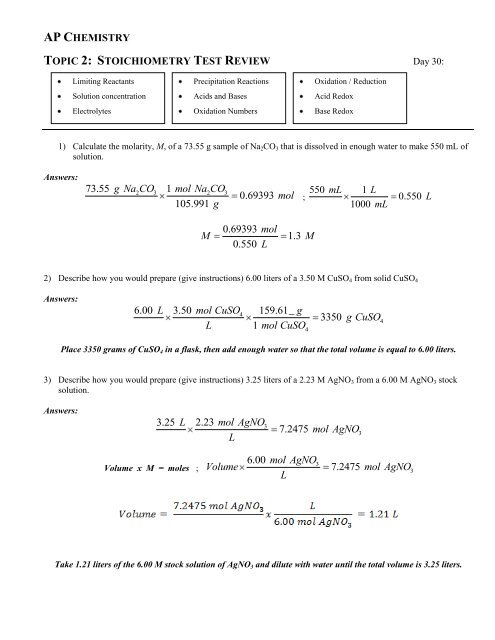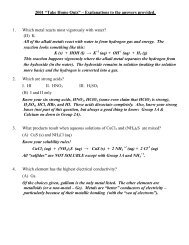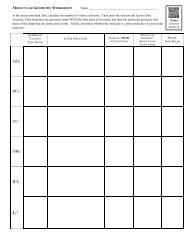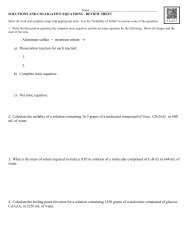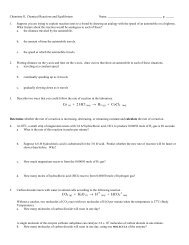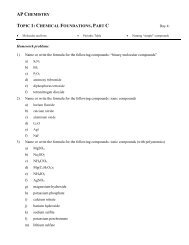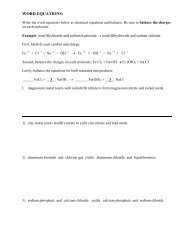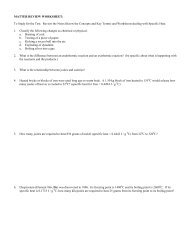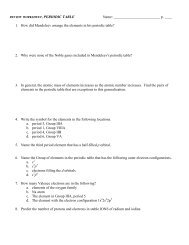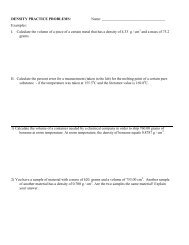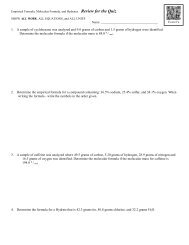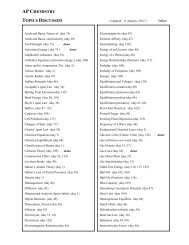Answers - Avon Chemistry
Answers - Avon Chemistry
Answers - Avon Chemistry
You also want an ePaper? Increase the reach of your titles
YUMPU automatically turns print PDFs into web optimized ePapers that Google loves.
AP CHEMISTRY<br />
TOPIC 2: STOICHIOMETRY TEST REVIEW Day 30:<br />
Limiting Reactants<br />
Solution concentration<br />
Electrolytes<br />
Precipitation Reactions<br />
Acids and Bases<br />
Oxidation Numbers<br />
Oxidation / Reduction<br />
Acid Redox<br />
Base Redox<br />
1) Calculate the molarity, M, of a 73.55 g sample of Na 2 CO 3 that is dissolved in enough water to make 550 mL of<br />
solution.<br />
<strong>Answers</strong>:<br />
73.55 g Na CO 1 mol Na CO<br />
105.991 g<br />
2 3 2 3<br />
0.69393<br />
mol<br />
; 550 mL 1 L<br />
0.550<br />
1000 mL<br />
L<br />
M<br />
0.69393<br />
0.550<br />
mol<br />
L<br />
1.3<br />
M<br />
2) Describe how you would prepare (give instructions) 6.00 liters of a 3.50 M CuSO 4 from solid CuSO 4<br />
<strong>Answers</strong>:<br />
6.00 L 3.50 mol CuSO4<br />
159.61_ g<br />
L 1 mol CuSO<br />
4<br />
3350<br />
g CuSO<br />
4<br />
Place 3350 grams of CuSO 4 in a flask, then add enough water so that the total volume is equal to 6.00 liters.<br />
3) Describe how you would prepare (give instructions) 3.25 liters of a 2.23 M AgNO 3 from a 6.00 M AgNO 3 stock<br />
solution.<br />
<strong>Answers</strong>:<br />
3.25<br />
L<br />
2.23<br />
mol AgNO<br />
L<br />
3<br />
7.2475<br />
mol AgNO<br />
3<br />
Volume x M = moles ;<br />
Volume<br />
6.00<br />
mol AgNO<br />
L<br />
3<br />
7.2475<br />
mol AgNO<br />
3<br />
Take 1.21 liters of the 6.00 M stock solution of AgNO 3 and dilute with water until the total volume is 3.25 liters.
4) Calculate the mass, in grams, of the precipitate formed when 135.22 mL of a 3.45 M copper(II) sulfate solution is<br />
mixed with 123 mL of a 3.30 M sodium hydroxide solution.<br />
<strong>Answers</strong>:<br />
CuSO 4 + 2 NaOH Cu(OH) 22<br />
+ Na 2 SO 4<br />
123 mL 1 L 3.30 mol NaOH 1 mol CuSO4<br />
L 1000 mL<br />
1000 mL L 2 mol NaOH 3.45 mol CuSO 1 L<br />
4<br />
58.8<br />
mL<br />
NaOH is the Limiting Reactant<br />
123 mL 1 L 3.30 mol NaOH 1 mol Cu( OH )<br />
2<br />
97.8658 g<br />
1000 mL L 2 mol NaOH 1 mol Cu( OH )<br />
2<br />
19.8 g Cu( OH )<br />
2<br />
5) A stock solution containing Ni +3 ions was prepared by dissolving 425 grams of pure nickel metal in nitric acid and<br />
diluting to a final volume of 4.50 L. Calculate the concentrations of the stock solution and the diluted solution if<br />
250 mL of the stock solution was diluted to 733.0 mL.<br />
<strong>Answers</strong>:<br />
Stock Solution:<br />
425 g Ni 1 mol Ni<br />
58.69 g<br />
3 3<br />
7.24144<br />
mol Ni<br />
3<br />
Dilute Solution:<br />
M<br />
7.24144 mol Ni<br />
4.50 L<br />
3<br />
1.61<br />
M<br />
250 mL Ni 1 L 1.61 mol Ni<br />
1000 mL L<br />
3 3<br />
0.402<br />
mol Ni<br />
3<br />
M<br />
0.402 mol Ni<br />
0.733 L<br />
3<br />
0.55<br />
M
6) Identify the oxidizing agent, the reducing agent, the substance being reduced, and the substance being oxidized.<br />
Mg (s) + HCl (aq)<br />
MgCl 2 (aq) + H 2 (g)<br />
1(2)<br />
0 1 1 2 0<br />
Mg 2 H Cl Mg Cl H<br />
2 2<br />
Mg 0 is oxidized, H +1 is reduced, HCl is the oxidizing agent, Mg is the reducing agent<br />
7) Write out the complete equation.<br />
a) HNO 3 (aq) + Mg(OH) 2 (s)<br />
2 HNO 3 (aq) + Mg(OH) 2 (s) 2 HOH (l) + Mg(NO 3 ) 2 (aq)<br />
b) H 2 SO 4 (aq) + LiOH (aq)<br />
H 2 SO 4 (aq) + 2 LiOH (aq)<br />
Li 2 SO 4 (aq) + 2 HOH (l)<br />
8) A 96.2 mL sample of hydrosulfuric acid solution requires 33.7 mL of a 4.80 M potassium hydroxide for complete<br />
neutralization. What is the concentration of the original hydrosulfuric acid solution<br />
H 2 S (aq) + 2 KOH (aq)<br />
2 HOH (l) + K 2 S (aq)<br />
33.7 mL KOH 1 L 4.80 mol KOH 1 mol H2S<br />
1000 mL L 2 mol KOH<br />
0.08088<br />
mol H S<br />
2<br />
M<br />
0.08088 mol H2S<br />
0.0962 L<br />
0.841<br />
M<br />
9) Determine the oxidation number for each ELEMENT in the chemical formula<br />
a) Na 2 SO 3<br />
b) Sn(ClO 3 ) 4<br />
Na: (2) +1 = +2<br />
S: (1) +4 = +4<br />
O: (3) –2 = - 6<br />
0<br />
Sn: (1) +4 = +4<br />
Cl: (4) +5 = +20<br />
O: (12) –2 = - 24<br />
0
10) Balance the following REDOX equation that occur in an Acidic solution:<br />
Cr 2 O 2– 7 + I – Cr 3+ + IO – 3<br />
Cr2O7 2– + I– Cr3+ + IO3 –<br />
3 H 2 O + I– IO3 – + 6 e - + 6 H +1<br />
6 e - + 14 H +1 + Cr 2 O 7<br />
2-<br />
2 Cr 3+ + 7 H 2 O<br />
6 e - + 14 H +1 + Cr 2 O 7<br />
2-<br />
+ 3 H 2 O + I– IO3 – + 6 e - + 6 H +1 + 2 Cr 3+ + 7 H 2 O<br />
8 H +1 + Cr 2 O 7<br />
2-<br />
+ I– IO3 – + 2 Cr 3+ + 4 H 2 O<br />
11) Balance the following REDOX equation that occur in an Basic solution:<br />
MnO 4<br />
– + Br – MnO 2 + BrO 3<br />
–<br />
MnO4 – + Br– MnO2 + BrO3 –<br />
3 H 2 O + Br– BrO3 – + 6 e - + 6 H +1<br />
2 ( 3 e - + 4 H +1 + MnO4 – MnO2 + 2 H 2 O )<br />
6 e - + 8 H +1 + 2 MnO4 – + 3 H 2 O + Br– 2 MnO2 + 6 e - + 6 H +1 + BrO3 – + 4 H 2 O<br />
2 H +1 + 2 MnO4 – + Br– 2 MnO2 + BrO3 – + H 2 O<br />
2 HOH + 2 MnO4 – + Br– 2 MnO2 + BrO3 – + H 2 O + 2 OH -1<br />
HOH + 2 MnO4 – + Br– 2 MnO2 + BrO3 – + 2 OH -1


